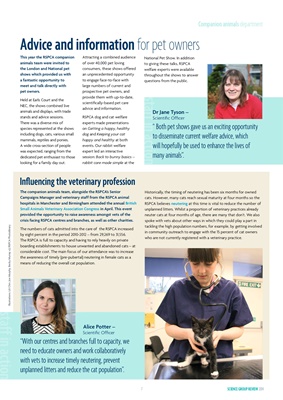
7 SCIENCE GROUP REVIEW 2014
Companion animals department
Advice and information for pet owners
staff in action
Dr Jane Tyson -
Scientific Officer
" Both pet shows gave us an exciting opportunity
to disseminate current welfare advice, which
will hopefully be used to enhance the lives of
many animals".
This year the RSPCA companion
animals team were invited to
the London and National pet
shows which provided us with
a fantastic opportunity to
meet and talk directly with
pet owners.
Held at Earls Court and the
NEC, the shows combined live
animals and displays, with trade
stands and advice sessions.
There was a diverse mix of
species represented at the shows
including dogs, cats, various small
mammals, reptiles and ponies.
A wide cross-section of people
was expected, ranging from the
dedicated pet enthusiast to those
looking for a family day out.
Attracting a combined audience
of over 40,000 pet loving
consumers, these shows offered
an unprecedented opportunity
to engage face-to-face with
large numbers of current and
prospective pet owners, and
provide them with up-to-date,
scientifically-based pet care
advice and information.
RSPCA dog and cat welfare
experts made presentations
on Getting a happy, healthy
dog and Keeping your cat
happy and healthy at both
events. Our rabbit welfare
expert led an interactive
session: Back to bunny basics -
rabbit care made simple at the
Influencing the veterinary profession
staff in action
Alice Potter -
Scientific Officer
"With our centres and branches full to capacity, we
need to educate owners and work collaboratively
with vets to increase timely neutering, prevent
unplanned litters and reduce the cat population".
National Pet Show. In addition
to giving these talks, RSPCA
welfare experts were available
throughout the shows to answer
questions from the public.
The companion animals team, alongside the RSPCA's Senior
Campaigns Manager and veterinary staff from the RSPCA animal
hospitals in Manchester and Birmingham attended the annual British
Small Animals Veterinary Association Congress in April. This event
provided the opportunity to raise awareness amongst vets of the
crisis facing RSPCA centres and branches, as well as other charities.
The numbers of cats admitted into the care of the RSPCA increased
by eight percent in the period 2010-2012 - from 29,269 to 31,556.
The RSPCA is full to capacity and having to rely heavily on private
boarding establishments to house unwanted and abandoned cats - at
considerable cost. The main focus of our attendance was to increase
the awareness of timely (pre-pubertal) neutering in female cats as a
means of reducing the overall cat population.
Historically, the timing of neutering has been six months for owned
cats. However, many cats reach sexual maturity at four months so the
RSPCA believes neutering at this time is vital to reduce the number of
unplanned litters. Whilst a proportion of veterinary practices already
neuter cats at four months of age, there are many that don't. We also
spoke with vets about other ways in which they could play a part in
tackling the high population numbers, for example, by getting involved
in community outreach to engage with the 15 percent of cat owners
who are not currently registered with a veterinary practice.
Illustrations: Lili Chin. Joe Murphy, Becky Murray x2/RSPCA Photolibrary